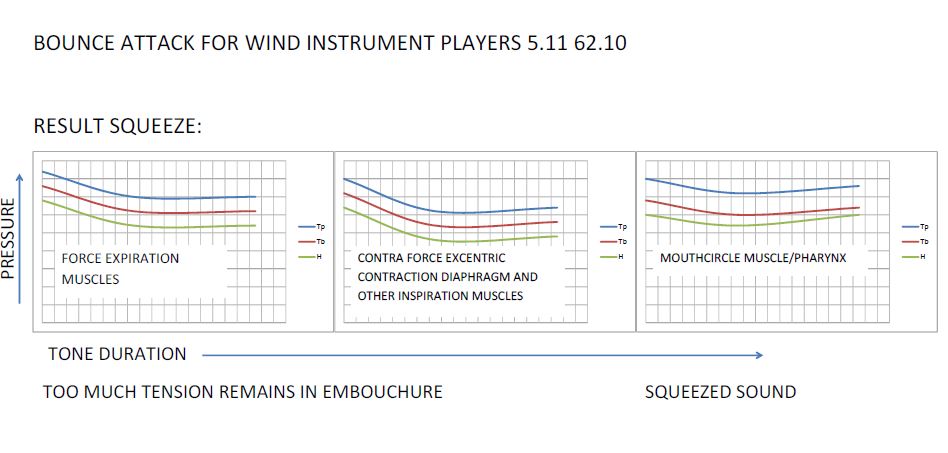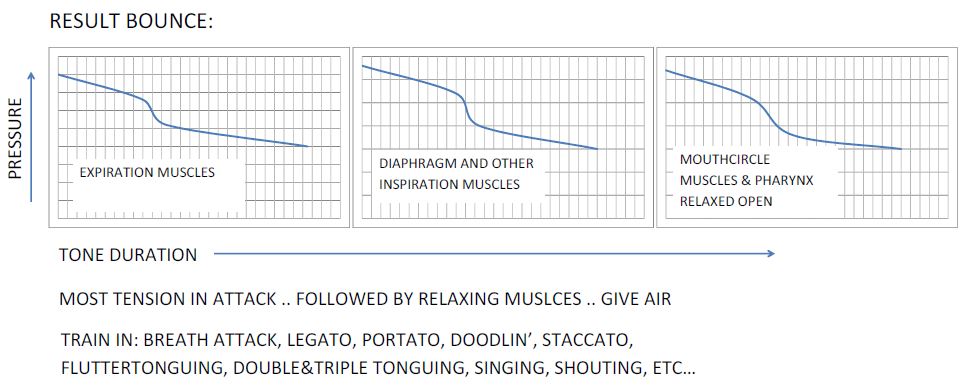| Hoofdstuk 5 - Paragraaf 9 |
5. Ademsteun

5.9 Bounce Attack
BOUNCE ATTACK VERSUS SQUEEZED ATTACK
Verende aanzet tegenover (te) geknepen aanzet.
Bij het aanzetten van een toon, het aanblazen ervan op een blaasinstrument, ongeacht of het hout of koper is, kan zich een belangrijk probleem voordoen. Saxofoon, trompet, hobo, fagot, hoorn ,bloklfluit, tuba, klarinet het maakt niet uit. Het probleem is in grote lijnen hetzelfde.
In feite is het een simpel probleem gezien uit de neurofysiologie.
Bij een foetus, zie de afbeelding van Netter, is er na een aantal weken de aanleg van zenuwverbindingen tussen het middenrif, rug- en buikwand en het gebied van het strottenhoofd, keelholte, kauwspieren, mondholte , tong en lippen.
De Nervus Vagus is hiervan de belangrijkste.
Vandaar dat je bij beginnende blazers al snel oefeningen op moet geven die het ademsysteem verbinden met de keel, tong, kaak- en lippenfuncties. De kans op slagen van een mogelijke blazerscarriere later wordt daarmee vergroot.
Door de aan aanwezigheid van deze zenuwverbindingen blijkt later dat, als jij een te grote en te langdurige druk laat uitoefenen op de buikinhoud en op het middenrif door je uitademingsspieren, het middenrif en andere inademingsspieren hun functie van eerste luchtsluis-regulateurs vanuit te drijven lucht , hun contrapressure ook zullen vergroten. Anders zou de lucht te snel in het instrument verdwijnen. Zie SQUEEZE ATTACK GRAFIEKJES..
Rood = trompet
Blauw=trombŰne
Groen=hoorn
Maar er zouden ook andere instrumenten ingevuld kunnen worden.
Kennelijk wordt door deze reflexverbindingen de tweede luchtsluis ook verhoogd actief en die bestaat uit keelholte, mondholte, kauwspieren, zachte verhemeltespieren en lippen.
En dat kun je direct horen in een geknepen toon en je ziet het in de toonspectra.
Daar waar je in BOUNCE ATTACK een terugloop ziet van het toonspectrum beneden de grondtoon is dat bij de Squeezed Attack niet het geval.
Je ziet en hoort dit veel bij amateur spelers maar ook wel bij profiís.
De druk die je uit moet oefenen om een toon te starten is in het begin groot maar moet direct afnemen om ontspanning te krijgen van zowel de uitademingsspieren(de ademsteun bedoel ik daarmee) en daarmee tevens ook de vermindering van de tegendruk van het middenrif en andere uitademingsspieren. Dat houdt dan min of meer gelijke tred met de spanning in en rond keel- en mondholte cq de lippenspleet of spanning van de lippen.
Met andere woorden: wel ademsteun maar niet meer dan nodig. Zie in de home page de Socratesmethode waar per noot precies staat wat te doen.
Lip- en gebitsblessures komen hierdoor veel voor en dan wordt het al gauw dystonie genoemd, ten onrechte.
In de toonspectra grafieken zie je de normale gang van zaken waarbij de gekleurde grafieken duidelijk het verloop aangeven van de nevenfrequenties (boventonen) die te nadrukkelijk aanwezig blijven. En dat geeft dus de geknepen , onmuzikale toon. STIFF SOUND noemen wij dat.
De Bounce Attack is een min of meer verende aanzet die te vergelijken is met de spraak of met zang. De spanning op alle groepen betrokken spieren is het grootst tijdens de aanzet en direct daarna moet beoordeeld worden hoeveel gas je terug neemt.
A lot of players play with a fault attack. I call it THE SQUEEZED ATTACK. A lot of amateurs and some profs use this way of playing.They learned it from their teacher. The result is that more often there appear injuries, mostly on the lips.Thereby is the sound production narrow, squeezed and not pretty to listen. In the tonal spectra you see that the lower overtones remain during the tone duration.The dynamics in the sound disappears, you get a stiff sound.


Klik op een plaatje om het te vergroten.
Picture overtones.
Its not difficult to discover this problem. There are too much remaining high tense after the attack in the expiration muscles from abdomen, back , chest and throat. The players donít relax enough after the attack.You should the instrument let sound, after the attack, bij the air column.The expiration force remains or stay too high.
2. The consequence is that the inspiration muscles, the diaphragm included ,keep also a too high tense.They must give the contra force against the press of the expirational muscles, to control how much air and in which fastness itís allowed to let pass through the pharynx, throat , mouthcavity , lipapertura and mouthpiece bore.
3. Through this measures from expirational muscles and the too high a tension during the whole tone there develops automaticly too high a tense of pharynx, mouth cavity and lips.In this way of breathing and breath supporting the press on the lip is also too high.There is too little relaxation. The instrument is pushed too much in or against the mouth. Also the press from the arms is also too high. Often there appears injuries on the lips and the dents.
Often there is a little bit more pucker iniative from the M. orbicularis oris (mouthcircle muscle. a.s.o.)
This 3 elements are connected with each other along the neurofysiological schedule). Its difficult to seperate this 3 elements from each other. It ís a reflex business.Thatís partly based on the connections between diaphragm and brain nerves of the throat and mouth(N.vagus).

BOUNCE ATTACK
The secret to solve this problem is in learning to relax the expiration muscles for an part direct after the attackmovement. You need only the press to continue the sound in the instrument by giving much air with less force.
This kind of Squeezed Embouchure and squeezed Attack hinders play with a open mouth, an open lipapertura. Direct after the attack you diminish all forces and try to give less press with the mouthpiece, with an open lipapertura. By means the pressure of the expirational muscles you must try to give less tense. The consequence will be that the inspirational muscles, like as the diaphragm and chestmuscles will be tensed less also.
The press from your arms and hands toward your face must be decreased too. Let the aircolumn sound and the wavecrosses do their work.
Playing in this way give better musical dynamic results, less tense en less injuries too.
Pictures overtones
 
Film with Hans plays Squeezed Attack and Bounce Attack
|
